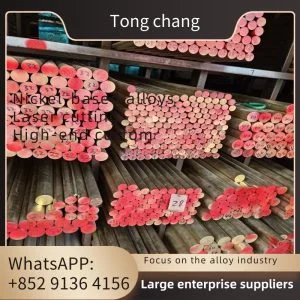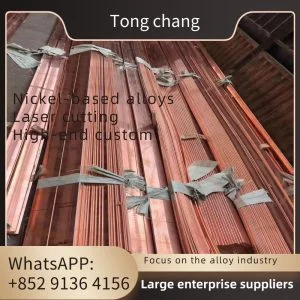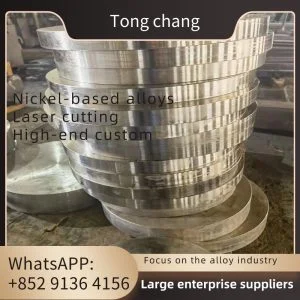| Product Name: | Tubesheet | Standard: | ASTM A516, ASME SA516 |
|---|---|---|---|
| Material: | Alloy Steel, Stainless Steel, Carbon Steel, Copper Steel | Size: | Can Custom, As Buyer’s Drawing Requirements |
| Shape: | Cylinder | NDT: | 100% PT, UT, PMI |
| Application: | Tubular Heat Exchanger, Boiler, Pressure Vessel, Steam Turbine, Large Central Air Conditioning, Etc. | ||
| High Light: | ASTM A516 Gr.70N Carbon Steel Tubesheet, Forged Heat Exchanger Parts | ||
ASTM A516 GR.70N Carbon Steel Forged Tubesheet Heat Exchanger Parts
A tube sheet is a plate that is used to support and seal the tubes in a heat exchanger or a boiler. It acts as a barrier between the tubes carrying the fluid and the shell, preventing leaks or mixing of the fluids. The tube sheet is typically made from a material that is compatible with the tubes and the operating conditions.
When referring to an ASTM A516 GR.70N tubesheet, it means that the tube sheet is made from ASTM A516 Grade 70N steel. This steel grade is known for its high strength, good weldability, and excellent notch toughness. It is commonly used in the fabrication of tube sheets for heat exchangers, boilers, and other pressure vessels. The use of ASTM A516 Grade 70N for a tubesheet ensures that it can withstand the required pressure and temperature conditions without failure, ensuring the safety and efficiency of the heat exchanger or boiler.
ASME SA516 Grade 60 / ASME SA516 Grade 70 – Chemical Requirements
| Element | Composition % | ||||
| Grade 55 [Grade 380] | Grade 60 [Grade 415] | Grade 65 [Grade 450] | Grade 70 [Grade 485] | ||
| Carbon, max a,b : | |||||
| 1⁄2 in. [12.5 mm] and under | 0.18 | 0.21 | 0.24 | 0.27 | |
| Over 1⁄2 in. to 2 in. [12.5 to 50 mm], incl | 0.20 | 0.23 | 0.26 | 0.28 | |
| Over 2 in. to 4 in. [50 to 100 mm], incl | 0.22 | 0.28 | 0.25 | 0.30 | |
| Over 4 to 8 in. [100 to 200 mm], incl | 0.24 | 0.27 | 0.29 | 0.31 | |
| Over 8 in. [200 mm] | 0.26 | 0.27 | 0.29 | 0.31 | |
| Manganese, b : | |||||
| 1⁄2 in. [12.5 mm] and under | |||||
| Heat analysis | 0.60–0.90 | 0.60–0.90 c | 0.85–1.20 | 0.85–1.20 | |
| Product analysis | 0.55–0.98 | 0.55–0.98 c | 0.79–1.30 | 0.79–1.30 | |
| Over 1⁄2 in. [12.5 mm]: | |||||
| Heat analysis | 0.60–1.20 | 0.85–1.20 | 0.85–1.20 | 0.85–1.20 | |
| Product analysis | 0.55–1.30 | 0.79–1.30 | 0.79–1.30 | 0.79–1.30 | |
| Phosphorus, max a | 0.25 | 0.25 | 0.25 | 0.25 | |
| Sulphur, max a | 0.25 | 0.25 | 0.25 | 0.25 | |
| Silicon | |||||
| Heat analysis | 0.15–0.40 | 0.15–0.40 | 0.15–0.40 | 0.15–0.40 | |
| Product analysis | 0.13–0.45 | 0.13–0.45 | 0.13–0.45 | 0.13–0.45 | |
| a Applies to both heat and product analyses. b For each reduction of 0.01 percentage point below the specified maximum for carbon, an increase of 0.06 percentage point above the specified maximum for manganese is permitted, up to a maximum of 1.50 % by heat analysis and 1.60 % by product analysis. c Grade 60 plates 1⁄2 in. [12.5 mm] and under in thickness may have 0.85–1.20 % manganese on heat analysis, and 0.79–1.30 % manganese on product analysis. | |||||
ASME SA516 Grade 60 / ASME SA516 Grade 70 – Tensile Requirements
| ASTM A516 | Grade 55 [380] | Grade 60 [415] | Grade 65 [450] | Grade 70 [485] |
| Tensile strength, ksi [MPa] | 55–75 [380–515] | 60–80 [415–550] | 65–85 [450–585] | 70–90 [485–620] |
| Yield strength, min,a ksi [MPa] | 30 [205] | 32 [220] | 35 [240] | 38 [260] |
| Elongation in 8 in. [200 mm], min, % b | 23 | 21 | 19 | 17 |
| Elongation in 8 in. [50 mm], min, % b | 27 | 25 | 23 | 21 |
| a Determined by either the 0.2 % offset method or the 0.5 % extension-under-load method. b See Specification A20/A20M for elongation adjustment. | ||||
Equivalent Specifications and Standards of ASME SA516 Grade 60 / ASME SA516 Grade 70
| Standard | ASME SA516 Grade 60 | ASME SA516 Grade 70 |
| ASME | ASTM A516 Grade 60 | ASTM A516 Grade 70 |
| DIN Standard | DIN 17155 HII | – |
| British Standard | BS1501-161-430A | BS1501-224-490A/B |
| European Norm | EN10028 P265GH | EN10028 P355GH |
Type of materials | Technical requirements according to |
Duplex Stainless Steel | ASTM/ASME SA182 F44, F45, F51, F53, F55, F60, F61 |
Stainless Steel | ASTM/ASME SA182 F304,304L,F316,316L, F310, F317L, F321, F347 |
Carbon Steel | ASTM/ASME A105, A350 LF1, LF2, A266, A694, A765 Gr.2 |
Alloy Steel | ASTM/ASME SA182 F1, F5, F9, F11, F12, F22, F51, A350-LF3 |
Titanium | ASTM/ASME SB381, Gr.1, Gr.2, Gr.5, Gr.7, Gr.12, Gr.16 |
Copper Nickel | ASTM/ASME SB151, UNS 70600(Cu-Ni 90/10), 71500(Cu-Ni 70/30) |
Brass, Al-brass | ASTM/ASME SB152 UNS C10100, C10200,C10300,C10800,C12200 |
Nickel Alloys | ASTM/ASME SB169,SB171, SB564, UNS 2200, UNS 4400, UNS 8825 |
Alloy 20 | ASTM/ASME SB472 UNS 8020 |
Hastelloy | ASTM/ASME SB564, UNS10276 ( C 276 ) |
Claded materials | ASTM/ASME SB898, SB263, SB264 or closer |
Titanium- Steel, Nickel-Steel,Titanium- Copper, |
The usage of tubesheets includes:
Tube Support: The primary function of a tubesheet is to provide structural support to the tubes within a heat exchanger or a boiler. The tubes are inserted into the holes on the tubesheet, ensuring they are securely held in place.
Fluid Separation: Tubesheets also act as a barrier between different fluid streams within a heat exchanger. They prevent mixing of the fluids by ensuring a tight seal around the tubes, thereby maximizing heat transfer efficiency.
Tube Alignment: Tubesheets play a crucial role in maintaining proper alignment of the tubes. They ensure that the tubes are evenly spaced and parallel to each other, which promotes efficient heat transfer and fluid flow.
Heat Transfer: The design of the tubesheet directly influences the heat transfer capabilities of a heat exchanger or a boiler. By choosing the appropriate materials and optimizing the hole pattern, the tubesheet can enhance the transfer of thermal energy between the fluid streams.
Corrosion Resistance: Tubesheets are often made from corrosion-resistant materials, especially in applications where the fluids being processed are corrosive. This helps to prolong the lifespan of the heat exchanger or boiler by reducing the risk of leaks or tube failures due to corrosion.
Leak Prevention: A tubesheet provides a secure joint between the tubes and the tube sheet. When properly installed and maintained, it helps prevent leakage of fluids from the heat exchanger or boiler, ensuring the system operates safely and efficiently.








